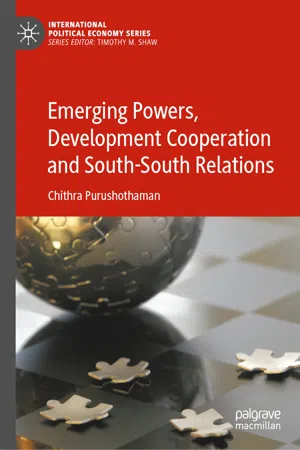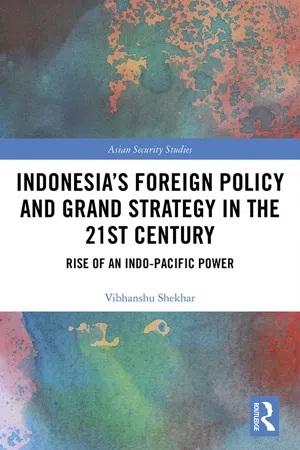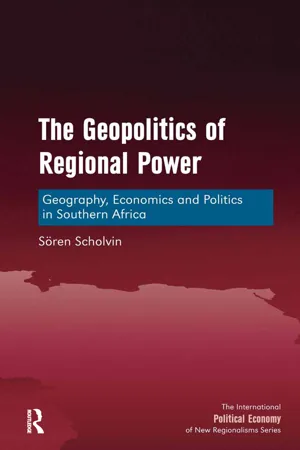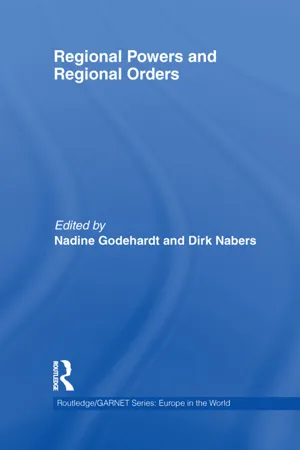Emerging Powers
Emerging powers refer to countries that are rapidly increasing their economic, political, and military influence on the global stage. These nations are often characterized by their growing industrialization, urbanization, and technological advancements. Examples of emerging powers include Brazil, Russia, India, China (BRIC), and other countries with similar trajectories of development and influence.
6 Key excerpts on "Emerging Powers"
- Chithra Purushothaman(Author)
- 2020(Publication Date)
- Palgrave Macmillan(Publisher)
...The expression “emerging country” 7 comes from the field of economics and even finance. The term “emerging market economies”, which is in use since the 1980s, refers to “rapidly growing economies that offer investment opportunities for companies in developed countries” (Jaffrelot 2008, 1). With the growing economic weight of some developing countries in the world economy, the term emerging power came to be used primarily to denote their “economic take-off” (Jaffrelot 2008, 1, 2). Gabas and Losch (2008) observe that these developing countries were those “underdeveloped category” of countries, which emerged after the Second World War that was later renamed as Third World countries and then rechristened as the Global South (Gabas and Losch 2008, 15). Andrew Hurrell (2006) argues that the Emerging Powers are countries that could be considered as “pivotal states in international relations” (Hurrell 2006, 9). These countries aim to manoeuvre a greater role and influence, in both their own region and the outside world (Hurrell 2006, 9; 2008, 4). It is through their increasing economic capabilities that they hope to change the economic and political setting of the twenty-first century (Hart and Jones 2010, 65). However, the concept of Emerging Powers presupposes common traits. Chenoy (2010) lays out the characteristics of an emerging power, including high growth rates; influence on international economics through purchase of bonds, impact on trade, foreign exchange and competitiveness; stable political systems and demographic depth. They are also found to be high military spenders with huge standing armies. (Chenoy 2010, 2) These countries, through their increasing military spending and nuclear capabilities, aim to enhance their regional and international influence (Chenoy 2010). They are also increasingly found to have strategic partnerships with other developing countries...
- eBook - ePub
Indonesia's Foreign Policy and Grand Strategy in the 21st Century
Rise of an Indo-Pacific Power
- Vibhanshu Shekhar(Author)
- 2018(Publication Date)
- Routledge(Publisher)
...They are marked by substantial differences ‘in terms of their power and geopolitical importance; economic weight and degree of integration into the global economy; distinctive cultural and historical trajectories; and their domestic political systems’. 11 They are variously labelled as ‘rising powers’, ‘aspiring powers’, ‘leading powers’, ‘major powers’, ‘new-Emerging Powers’, ‘global swing states’, regional powers, ‘emerging markets’, ‘pivotal states’ and ‘middle Emerging Powers’. 12 They are also characterized as would-be great powers and today’s Emerging Powers are on the way to become great powers. 13 These Emerging Powers are also termed as ‘Quasi world powers’, ‘capable of competing for the position of a world power and on the threshold of becoming one in the near future’. 14 Alastair Iain Johnston posits five different approaches to identify a rising power – a historical view (i.e. a state is rising if it is more powerful than the past); a visibility view (a state is more engaged in the world than previously); an influence view (a state increasingly affects the lives of ordinary people); a ‘threat to the hegemon’ view; and an ‘inter-subjective expectations’ view (i.e. a state is rising if other states view it as having a larger role in the world than in the past). 15 While the first and third approaches relate to an increase in the states’ capabilities as a defining element of the Emerging Powers, the second and fifth approaches relate to international recognition of emerging power status. The fourth view of Emerging Powers as a threat to the hegemon allude to the ways in which Emerging Powers express their international ambition...
- eBook - ePub
The Geopolitics of Regional Power
Geography, Economics and Politics in Southern Africa
- Sören Scholvin(Author)
- 2016(Publication Date)
- Routledge(Publisher)
...Chapter 1 Introduction Core Question and Purpose of this Study Emerging Powers are new key players in international affairs. Most prominently, China and India have been labelled ‘new drivers of global change’, with their rise restructuring global governance (Humphrey and Messner 2005; Kaplinsky 2005). The rapid economic growth of certain countries poses a challenge to the Global North. The BRIC grouping – that is, Brazil, Russia, India and China – is likely to dominate the global economy in terms of output by 2050 (O’Neill 2001; O’Neill et al. 2005; Wilson and Purushothaman 2003). Smaller emerging economies – the so-called ‘N-11’ – are also predicted to overtake some of the major economies from the Global North in terms of gross domestic product in the first half of the twenty-first century, although they will not reach the size and importance of BRIC (Wilson and Stupnytska 2007). There are various theoretical concepts that capture the potential that Emerging Powers have to be partners of the West. In development studies, the former are referred to as ‘anchor countries’ by the German Development Institute (Stamm 2004) and as ‘pivotal states’ by Chase, Hill and Kennedy (1996, 1999). Both terms revolve around the idea that the economic and political development of these states determines the relative development of their neighbourhoods. Scholars of the German Institute for International and Security Affairs examine states that are able to shape specific policies either constructively or detrimentally, the so-called ‘leading powers’, as partners for Germany (Husar et al. 2008; Husar and Maihold 2009). Barnett (2003, 2004, 2005), a former consultant for the Pentagon, proposes a new form of cooperation between the United States, its European partners and Emerging Powers. Huntington (1996) writes that the dominant states of what he calls ‘civilisations’ may help to solve regional conflicts...
- eBook - ePub
- Amitav Acharya(Author)
- 2018(Publication Date)
- Polity(Publisher)
...4 Emerging Powers The Hype of the Rest? The terms “Emerging Powers” and “rising powers” recognize the growing economic as well as political and strategic status of a group of nations, most if not all of which were once categorized (and in some accounts still are) as part of the “third world” or “global South.” The definition of who belongs in these categories is neither fixed nor uncontroversial. These terms are often used to include countries such as the BRICS as well as Indonesia, Mexico, Argentina, Australia, Saudi Arabia, South Korea, and Turkey. Andrew Cooper has observed that “the depiction of rising powers” has been “expansive, fluid, and contested … No one acronym has the field to itself.” 1 The same can be said of the term “Emerging Powers.” For example, despite its seeming conflation with “Emerging Powers,” the term “rising powers” is normally associated with countries that have a clear potential to become great powers, such as China, India, and Brazil. The term “Emerging Powers” indicates countries such as Indonesia, South Korea, Mexico, Nigeria, and South Africa, which are not perceived to be headed for international great-power status. (For convenience, I will use the term “Emerging Powers,” a broader category which subsumes “rising powers.”) Russia is an odd presence in the ranks of the rising/Emerging Powers category, since it is really a traditional European great power, which was also a military superpower during the Cold War. (In the post-Cold War era, some saw it prematurely, as an “outdated great power.” 2) Another term that complicates the picture is that of “regional powers,” a category that relies more on physical and material attributes of a country relative to its immediate neighbors. Not all Emerging Powers are counted as regional powers, though...
- eBook - ePub
New Geographies of Global Policy-Making
South-South Networks and Rural Development Strategies
- Carolina Milhorance(Author)
- 2018(Publication Date)
- Routledge(Publisher)
...1 Emergence is More Than Just Economic Growth Are there any particularities in the international production and the circulation of norms by southern actors? Can we speak of a new phase of integration among southern societies and states since the 2000s? What is the role of the so-called ‘emerging’ powers in this process of integration, and how do we define this category? These questions drive this contextualisation chapter. To begin with, the chapter relies on the notion of international ‘emergence’ and begins with its politico-economic criteria. Moreover, the chapter also leans on the symbolic fundamentals of ‘emergence’, particularly linked to the notions of ‘development’ and ‘poverty’. Finally, it discusses the recent context of deepening ties between Emerging Powers and their southern partners. Empirical Context: Economic Growth and Diplomatic Activism Expansion of Economic Markets and Redefinition of the State’s Role Predominance of the Criteria of Economic Growth The ‘emerging markets’ were designated as rapidly transitioning and industrialising countries in the 1980s, presenting investment opportunities that resulted in their growth and the growth of their financial systems while also presenting remunerative investment risks, such as the Asian ‘tigers’ and ‘dragons’. The concept was coined by an International Finance Corporation (IFC) economist, a subsidiary of the World Bank, who wanted to demonstrate that contrary to the thinking of the time, the world’s economic centre of gravity was shifting progressively towards a number of developing countries. These countries enjoyed significant growth rates and presented a set of promising avenues for foreign investment that had previously been ignored. For example, the IFC’s Third World Investment Fund became the Emerging Markets Growth Fund: ‘Racking my brain, I at last came up with a term that sounded more positive and invigorating: emerging markets...
- eBook - ePub
- Nadine Godehardt, Dirk Nabers, Nadine Godehardt, Dirk Nabers(Authors)
- 2011(Publication Date)
- Routledge(Publisher)
...Economic power is thus always the result of a bargaining process; that is, it is relational. Technology and hegemony According to Richard R. Nelson and Gavin Wright, emerging nations can initiate a catching-up process and thereby ascend to the position of technologically leading nations. This depends above all on them: (1) raising the total factor productivities, 4 (2) increasing the investment and savings rates and (3) identifying new organizational forms in industry and the ‘political economies’. What is meant by this is that today’s global society is a network society and that research can be imitated anywhere, which means that technology can become a ‘public good’. Rising nations, such as regional powers, can use investments in education and in research and development (R&D) to more easily adapt developed countries’ technology, and thereby advance (Fan 2008 ; Altenburg et al. 2008 ; Nayyar 2008 ; Frietsch and Schüller 2010). Thus, according to Nelson, what regional powers need to develop their power status, aside from a mass-production market, is first and foremost technological leadership. Newer studies from Ricardo Hausmann and Dani Rodrik (2003) support this view. The authors compare the technology-adaptation process of companies in developing countries directly with the innovation process in industrialized countries. They model technological adaptation as a business process that involves similar risks and costs to the innovation process. Accordingly, regional powers do not simply dominate their neighbour countries: through local technological efforts the neighbouring countries in the region can increase their own productivity and develop technologically, meaning that they have something to use as leverage against the regional powers (Keller 2004). Power imbalances and asymmetries Regional powers influence neighbouring states in various ways...





